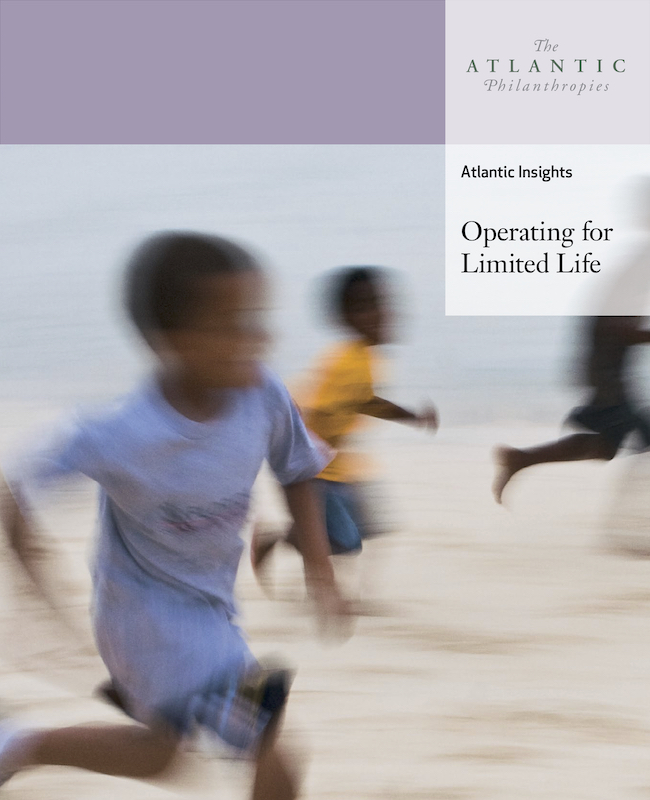Atlantic Insights Operating for Limited Life
About the Book
How Atlantic approached its limited life.
This Insights offers an in-depth look at Atlantic’s limited life journey. It covers:
- How grantmaking, human resources, finance, evaluation, communications and information technology evolved over the years to meet the challenges and opportunities of operating for a fixed period.
- Strategies used to maximize effectiveness and sustain and extend its impact.
- Lessons for funders contemplating limited life.

Introduction
A growing number of foundations are choosing to operate within a limited lifespan. While the reasons vary, in each case the organizations must address specific questions as they develop a plan to implement this decision. For The Atlantic Philanthropies, the commitment in 2002 to close its doors by 2020 reflected founder Chuck Feeney’s Giving While Living approach to philanthropy and his desire for the foundation’s funds to achieve maximum impact within that time frame and beyond.
Establishing an end date had critical implications for all aspects of Atlantic’s work and operations. As a multi-billion-dollar global philanthropy, it was the largest foundation ever to fully commit its endowment in a fixed period of time and voluntarily exit. Given the scale of Atlantic’s enterprise, it was essentially forging an uncharted course. As one senior manager noted: “There was no help desk that we could call.” What’s more, far from representing the kind of winding down trajectory that is typically associated with the term “spending out,” Atlantic’s culminating phase was conceived as a building up to make a lasting difference in the fields and regions where it had long been involved.
As Atlantic learned, there is no cookie cutter template for the limited-life journey.
In this Insights, Atlantic highlights the steps it took to address the challenges the foundation faced in navigating its path toward the end while seeking to accomplish ambitious programmatic goals: how limited life shaped investment, staffing, operations, grantmaking, evaluation, and communication strategies.
The report draws on an extensive review of foundation documents and in-depth interviews with senior leadership and current and former staff.
It covers both the nuts and bolts details as well as the thinking behind key decisions, the problems that arose, adjustments to strategy, and what was learned along the way. The volume is not meant to be a “how to” manual. There is no cookie cutter template for this journey, and in many ways Atlantic’s experience was shaped by factors unique to its situation.
The goal in distilling insights and lessons from Atlantic’s implementation story is to share knowledge that could be useful to emerging philanthropists and leaders of foundations considering limited life. The hope is that Atlantic’s experience will make a helpful contribution to the expanding body of literature on limited-life foundations. At the same time, colleagues at philanthropies that have no plans to close may find some of Atlantic’s experiences applicable to their work, especially when making plans to transition out of programs or changing grantmaking priorities.
Highlights
This Insights covers key operational activities Atlantic undertook over the course of its limited life:
- Developing and implementing plans to exit responsibility from some programs while also helping to sustain, expand and even start new work to create an enduring legacy of impact.
- Managing finances during a period the foundation was winding down, while also making major investments in new programs that will be active long after it closes.
- Determining the staff structure needed to the end and designing and implementing policies to sustain employee engagement, even as people become increasingly focused on their next career opportunities.
- Creating useful "knowledge products" from its rich trove of evaluative reports, designing a dynamic website and creating an active archive—efforts designed to influence philanthropic thinking and practice well into the future.
- Ensuring that information management systems met the foundation's changing needs during the period it was shrinking the size of its staff and completing its grantmaking.
Key Lessons
Here are some of the lessons Atlantic learned about operating as a limited-life foundation:
- Determine the end goals you want to achieve far in advance of your closing date, then work backward to formulate a plan for achieving them.
- A foundation can spend its final years focused on building up to make a lasting difference while at the same time it is winding down.
- It is essential to communicate to grantees early, clearly, and frequently about final foundation priorities, and the schedule for ending programs.
- Offering a strong severance policy, along with multiple transition resources, helps retain staff and keep them engaged until the end.
- The closer a foundation comes to its final years of grantmaking, the greater the need for an investment plan with low volatility and greater predictability to ensure it can accomplish its programmatic goals.
- To ensure knowledge gained over a foundation's history can help inform future philanthropic practice, start culling, synthesizing and archiving records early, while staff familiar with the work are still there. Consider partners to help reach your target audiences.

Download
Read it now.
This book offers useful lessons and insights about operating for limited life, setting grantmaking priorities and transitioning out of programs.
Download the full book (PDF) ›
Further Reading
